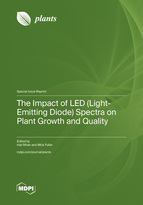The Impact of LED (Light-Emitting Diode) Spectra on Plant Growth and Quality
A special issue of Plants (ISSN 2223-7747). This special issue belongs to the section "Plant Physiology and Metabolism".
Deadline for manuscript submissions: closed (20 March 2023) | Viewed by 28234
Special Issue Editors
2. Consultant Professor, King Abdulaziz City for Science and Technology (KACST), Riyadh 11442, Saudi Arabia
Interests: new-generation LED technologies; impact of light spectra on growth, yield, chemistry, biology, and molecular information of plants; hydroponic production of high-value crops; breeding of wheat and cauliflower; abiotic stress (drought, cold, and salinity); molecular mechanism of plant abiotic stress tolerance (e.g., monitoring gene expression profiles/patterns and gene regulatory networks for understanding genetic control for crop improvement
Special Issues, Collections and Topics in MDPI journals
Interests: plant stress physiology: frost tolerance, ice nucleation, infrared thermal imaging, salt tolerance, drought tolerance; plant biotechnology: plant tissue culture, molecular biology crop physiology; agronomy: physiology of vegetable crops and cereals, climate change physiology, glasshouse crop physiology
Special Issues, Collections and Topics in MDPI journals
Special Issue Information
Dear Colleagues,
A new method of artificially grown light sources, light-emitting diodes (LEDs), has been intensively developed in recent years and now has potential for use in agricultural and horticultural production. LEDs have a linear photon output with electrical input current. LEDs also have a substantial potential importance in plant development because LEDs can be constructed in arrays big enough to provide enough PAR but still small in size (few centimeters in diameter) and still emit less heat than “traditional” high‐intensity discharge lighting lamps. LEDs are also known for their durability and long operating lifetime. LED arrays can be designed to have wavelength specificity, which is a key factor due to the fact that each plant species responds differentially to different light wavelengths due to specific differences in their photoreceptors. Plenty of research has investigated the role of LEDs in enhancing plant shape, edible quality, biomass, number of leaves, growth rate, and stem width. Simultaneously, research has demonstrated the effects of LEDs on chemical compounds such as vitamin C content, soluble sugar content, chlorophyll level, antioxidant activity, and different protein levels of many plant species.
For this Special Issue, articles (original research papers, perspectives, opinions, and reviews) that focus on the impact of LED light spectra on plant tissue culture programs, growth and yield of plants, essential oil content and chemical composition of pharmaceutical plant species, plant biochemistry, plant physiology, gene and protein expressions, plant metabolites and nutrition, and economical analysis of controlled environment agriculture (CEA) systems using LED lights are most welcome.
Prof. Dr. Hail Rihan
Prof. Dr. Mick Fuller
Guest Editors
Manuscript Submission Information
Manuscripts should be submitted online at www.mdpi.com by registering and logging in to this website. Once you are registered, click here to go to the submission form. Manuscripts can be submitted until the deadline. All submissions that pass pre-check are peer-reviewed. Accepted papers will be published continuously in the journal (as soon as accepted) and will be listed together on the special issue website. Research articles, review articles as well as short communications are invited. For planned papers, a title and short abstract (about 100 words) can be sent to the Editorial Office for announcement on this website.
Submitted manuscripts should not have been published previously, nor be under consideration for publication elsewhere (except conference proceedings papers). All manuscripts are thoroughly refereed through a single-blind peer-review process. A guide for authors and other relevant information for submission of manuscripts is available on the Instructions for Authors page. Plants is an international peer-reviewed open access semimonthly journal published by MDPI.
Please visit the Instructions for Authors page before submitting a manuscript. The Article Processing Charge (APC) for publication in this open access journal is 2700 CHF (Swiss Francs). Submitted papers should be well formatted and use good English. Authors may use MDPI's English editing service prior to publication or during author revisions.
Keywords
- LED (light-emitting diode)
- pharmaceutical plants
- light spectrum
- yield, photosynthesis
- photosynthetic photon flux
- secondary metabolism
- physiological regulation
- photoreceptors
- photobiology
- spectral composition








